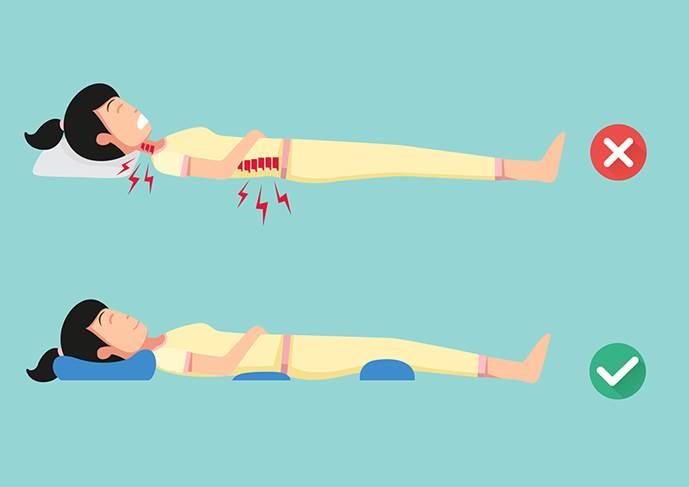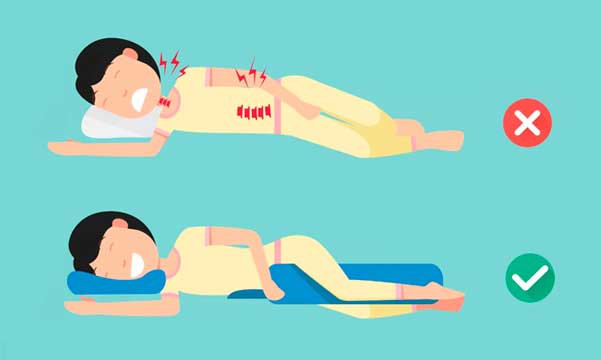The Best Sleeping Positions For A Healthy Spine
A good night's sleep is essential for better health. Also, the alignment of the spine is one of the most important factors impacting the sleep quality. A healthy spine is essential for maintaining mobility, minimizing pain, and preventing long-term musculoskeletal conditions.
Finding an appropriate sleeping position can help in reducing back strain and discomfort, and also helps in improving restful sleep. This article explores into the most effective sleeping positions to help maintaining the healthy spine, and the benefits they offer, and how to best utilize them for maximum comfort and spinal support.
The Importance of Spinal Alignment Throughout Sleep
The spine's natural S-shaped curve should always be maintained even while in the resting position. Poor sleeping positions can cause too much pressure on the vertebrae, leading to back pain, stiffness, and spinal alignment issues. Healthy spinal position during sleep spreads pressures evenly throughout the body, reducing strain on joints and muscles.
Best Sleeping Positions for a Healthy Spine
1. Sleeping on your back (Supine Position)
Benefits:
- It evenly distributes weight throughout the body.
- It maintains the spine's natural position its proper position.
- It reduces acid reflux (when followed with slight head elevation).
- It lowers the pressure points, decreasing the possibility of developing bed sores caused by pressure.
How to Make It More Effective:
- Making usage of a medium-firm mattress that supports the natural curvature of the spine.
- A pillow that supports the head's posture and the spine must be placed beneath it.
- To preserve the natural curvature of the spine, put a small pillow or rolled-up cloth underneath the knees.

2. The Lateral Position: Sleeping on Your Side
Benefits:
1. It minimizes the possibility of snoring and sleep apnea.
2. It maintains the spine neutral position, and helps alleviate the lower back pain.
3. It improves circulation, it is recommended for mothers who are expecting.
4. It is advantageous for those who struggle with acid reflux.
How to Make It More Effective:
- In order to keep the head and neck in alignment, it is always suggested to use a firm pillow.
- In order to maintain your hips and spine in a proper alignment, one should always place a pillow in between the knees.
- Regularly switching sides in order to prevent musculoskeletal imbalances.

3. Fetus Position
Benefits
1. It reduces spinal pressure by supporting in the opening of the gaps between vertebrae.
2. It reduces lower back strain, which is beneficial to people who have ruptured discs.
3. It improves blood flow and may benefit to the ones with arthritis.
How to Make It More Effective:
- Be cautious not to twist your back excessively, as this may lead to stiffness.
- To ease the strain on the lower back, always position a pillow between the knees.
- Get a cushion that fits correctly to keep the neck in alignment.
Picking the Appropriate Pillow and Mattress
Considerations for Mattresses
1. As the healthy spine depends upon an ideal mattress. A mattress of sufficient quality should be comfy as well as supporting.
2. Firmness Level: For spinal alignment, medium-firm mattresses are usually advised.
3. Material: Hybrid or memory foam mattresses also offer contoured support without causing unnecessary sinking.
Considerations for Pillows
The health of your spine can be greatly impacted by a suitable pillow:
1. Back sleepers: The natural curve of the neck is supported by a contoured cushion.
2. Side sleepers: A thick, firm pillow maintains the head aligned with the spine.
Sleeping in prone is never advised.
Durability: For the best support, replace your mattress every seven to ten years.
Extra Advice on Proper Sleep Position:
Appropriate Sleep Aids: For additional support, explore using toppers for mattresses and orthopedic pillows.
Maintain Proper Sleeping Hygiene: Avoid using gadgets right before bed while maintaining a regular sleep routine.
Stretch Before Bed: Stretching lightly may improve flexibility and decrease stress.
If you have an urge to move into different postures, use pillows that are placed carefully to keep your postural alignment.
Conclusion:
Spine health and a reduction of chronic pain depends on the sleeping position you select. While stomach sleeping should be minimized, sleeping on a side or back usually offers the better support for spinal alignment.
The convenience and wellness of the spine are further enhanced with a supportive mattresses and pillow. By following these suggested procedures, you can have a pain-free and healthy spine and additionally enhancing the quality of your sleep and overall wellness.
_1742634080_1751830720.png)



